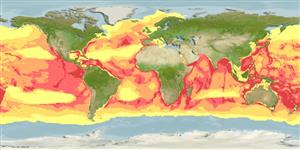Common names from other countries
Environment: milieu / climate zone / depth range / distribution range
Ecologie
Pelagisch; standvastig (Ref. 75906); diepteverspreiding 0 - 1989 m (Ref. 116169). Tropical; 90°N - 90°S, 180°W - 180°E
Indo-Pacific, Atlantic Ocean and the Mediterranean. Tropical to warm temperate zones.
Length at first maturity / Size / Gewicht / Leeftijd
Maturity: Lm ?, range 210 - 220 cm Max length : 270 cm TL mannelijk/geslacht niet bekend; (Ref. 1394); Maximaal gepubliceerd gewicht: 210.0 kg (Ref. 1394)
Usually in deeper offshore waters. Typically in groups of less than 5 individuals (Ref. 801). Feeds on deep water cephalopods (Refs. 801, 1394) and crustaceans (Ref. 122680).
Females may become pregnant in successive breeding seasons. Mating occurs in summer. Calving lasts over 5 months (Ref. 97768).
Jefferson, T.A., S. Leatherwood and M.A. Webber. 1993. (Ref. 1394)
Status op de Rode Lijst van het IUCN (Ref. 130435)
Status bij CITES (Ref. 108899)
Not Evaluated
Gebruik door de mens
Visserij: commercieel
FAO - Visserij: landings, soortsprofiel | FishSource | Sea Around Us
Tools
Meer informatie
Leeftijd/GrootteGroeiLengte-gewicht parametersLengte-lengte parametersMorfologieLarvenAbundantie
Internet-bronnen
Estimates based on models
Preferred temperature
(Ref.
115969): 2.4 - 13.9, mean 4.5 (based on 4397 cells).
Kwetsbaarheid
Very high vulnerability (90 of 100).
Prijsklasse
Unknown.
